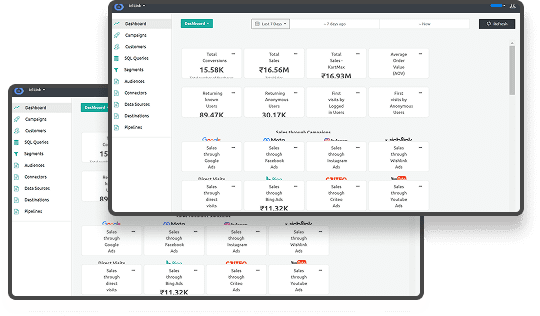Guide to Effective Ads Tracking
What if you could know exactly how your ads perform and fine-tune your marketing strategy in real-time?
Imagine being able to track each click, conversion, and interaction to ensure every dollar of your ad spend delivers maximum ROI. This is the power of tracking ads; it's necessary for every marketer looking to stay competitive.
As digital advertising becomes more sophisticated, tracking ads effectively allows businesses to make data-driven decisions, optimize campaigns, and truly understand customer behavior. Whether you’re running Facebook ads, Google Ads, or other campaigns, tracking gives you the insights you need to grow your business.
In this blog, we’ll explore the ins and outs of tracking ads, from what it is and why it matter, to best practices and common challenges. Let’s dive in and see how you can turn ad tracking into a game-changer for your marketing success!
What Is Ad Tracking?
Ad tracking refers to the process of collecting data on how users interact with online advertisements. It involves monitoring actions such as clicks, conversions, and impressions to measure the effectiveness of ad campaigns. Tracking ads helps marketers understand how well their ads perform, allowing them to make adjustments to improve engagement, optimize ad spend, and ultimately boost ROI.
Ad tracking relied heavily on third-party cookies to gather this data in the past, but with the growing emphasis on privacy, server-side tracking and first-party data are becoming increasingly popular as more privacy-friendly alternatives. By using ad tracking tools like Google Ads, Facebook Pixel, and Google Analytics, businesses can fine-tune their marketing strategies for greater success.
Now that you understand the importance of ad tracking, let’s explore its many benefits for marketing campaigns.
Benefits of Using Ad Tracking
Effective ad tracking offers numerous benefits that directly impact the success of your marketing campaigns:
1. Measure Campaign Success
Ad tracking allows you to determine how well your campaigns are performing by measuring key metrics like clicks, impressions, conversions, and ROI. This helps you identify which ads are driving the most value for your business.
2. Optimize Ad Spend
With insights into what’s working and what isn’t, you can allocate your budget to the ads and channels that deliver the highest returns. This ensures that your ad spend is used efficiently, maximizing your marketing budget.
3. Personalized User Experience
Tracking ad interactions helps you understand customer behavior, enabling you to serve more personalized ads that resonate with your target audience. Personalized ads lead to better customer engagement and increased conversions.
4. Retargeting Opportunities
Ad tracking allows you to retarget users who interacted with your ads but didn’t convert. You can remind them of the product they viewed, or offer incentives, which helps bring potential customers back to your site.
5. Improve Future Campaigns
By analyzing ad performance, you can pinpoint areas of improvement for future campaigns. Understanding what worked and what didn’t help you refine your strategies and improve your ad performance over time.
To dive deeper into how ad tracking can improve your marketing campaigns, read our blog on Understanding Multi-Touch Attribution.
Knowing exactly what you can track is essential to making the most of ad tracking. Let’s examine the key metrics that provide valuable insights.
What Can You Track With Ad Tracking?
With ad tracking, there are several key actions you can monitor to gain valuable insights into your campaigns:
- Impressions: How many times your ad is shown to users.
- Clicks: How many times users click on your ad.
- Conversions: The number of times users complete desired actions, such as making a purchase, signing up for a newsletter, or downloading an app.
- Bounce Rate: The percentage of users who visit a landing page and leave without interacting.
- Cost Per Click (CPC): How much you pay for each click on your ad.
- Click-Through Rate (CTR): The ratio of users who click on your ad to the number of total users who view it.
- Return on Ad Spend (ROAS): The revenue generated for every dollar spent on advertising.
By analyzing these metrics, you can gain deep insights into which ads are performing well, and which need optimization.
For more on tracking marketing campaigns, check out our blog on UTM Parameters and Best Practices for Tracking Campaigns.
Once you know what to track, understanding how ad tracking works is crucial for setting up your campaigns effectively. Let’s walk through the process step-by-step.
How Ad Tracking Works
Ad tracking works by embedding tracking mechanisms—usually in the form of pixels, tags, or cookies—into your ads or website. When a user interacts with an ad or visits a landing page, these tracking mechanisms collect data on their actions, which is then sent back to your analytics platforms for analysis.
Step-by-Step Process:
- Ad Interaction: The user clicks on or views your ad.
- Data Collection: A tracking pixel or tag collects information on the user's behavior, such as their device type, IP address, and actions on the page (e.g., whether they completed a purchase).
- Data Storage: The data is stored in analytics platforms like Google Analytics, Facebook Ads Manager, or your CRM.
- Analysis: You can now analyze the data to track performance, conversions, and ROI.
For more on optimizing your tracking setup, check out our blog on Server-Side Tagging: Why It’s Time to Shift the Game.
While tracking ads is critical, there are some challenges you might face. Let’s look at common issues and how to solve them.
Common Challenges in Tracking Ads and How to Solve Them
While tracking ads is essential for performance measurement, several challenges can arise. Here are some common issues and how to overcome them:
1. Ad Blockers
Ad blockers prevent tracking pixels from firing, meaning you lose valuable data on users who have them enabled.
Solution: Implement server-side tagging, which is more difficult for ad blockers to detect and block, ensuring better data collection.
2. Data Accuracy
Tracking tools can sometimes provide inaccurate data due to incorrect tag implementation or technical glitches.
Solution: Regularly audit your tracking setup to ensure that all tags, pixels, and scripts are firing correctly and that data is being captured accurately.
3. Privacy Regulations
With laws like GDPR and CCPA, privacy concerns are more important than ever.
Solution: Implement consent management tools to ensure you’re collecting user data responsibly and in compliance with privacy laws.
Learn more in our blog on What You Need to Know About Consent Management.
4. Data Overload
With multiple tracking tools, it’s easy to get overwhelmed with data that isn’t useful.
Solution: Focus on tracking key performance indicators (KPIs) and segment your data so you can analyze only the most relevant metrics for your business.
Now that you've learned how to overcome these challenges, let's focus on why first-party data plays a pivotal role in your ad tracking strategy.
Why Track with First-Party Data?
First-party data is the most reliable and valuable data you can use for ad tracking because it comes directly from your customers through interactions on your website, app, or other owned platforms.
Benefits of First-Party Data for Ad Tracking:
- Accuracy: First-party data is collected directly from users, making it more accurate than third-party data.
- Compliance: Using first-party data ensures you comply with privacy laws like GDPR and CCPA since the data is collected with user consent.
- Enhanced Personalization: First-party data allows you to tailor ads based on users’ specific behaviors, interests, and preferences, improving conversion rates.
To learn more about the power of first-party data, check out our blog on Crafting Unique Experiences with First-Party Data.
To make your ad tracking more effective, Ingest Labs offers tools that can simplify the process. Let’s take a closer look at how we can help.
How Ingest Labs Can Help with Tracking Ads
At Ingest Labs, we specialize in ethical first-party data collection, offering tools designed to enhance ad tracking while ensuring privacy compliance.
- Server-Side Tagging: We offer server-side tracking solutions that improve data accuracy and prevent tracking issues caused by ad blockers, ensuring seamless data collection.
- Real-Time Data Monitoring: Our platform provides real-time monitoring, so you can track your ad performance continuously and make adjustments as needed.
- Privacy Compliance: Ingest Labs ensures that your ad tracking practices comply with global privacy laws, protecting your business from potential fines and reputation damage.
- First-Party Data Integration: We help you leverage first-party data to enhance ad targeting and improve personalization, driving better results for your campaigns.
- Improved ROAS: With precise tracking and data-driven insights, businesses can optimize their ad spend, leading to a higher return on investment.
With the right tools in place, you’re ready to improve your ad tracking strategy and see better results.
Conclusion
Tracking ads is crucial for measuring the success of your marketing campaigns and optimizing your advertising spend. By utilizing tracking tools, focusing on first-party data, and overcoming common challenges, you can improve the performance of your ads and boost ROI.
At Ingest Labs, we offer innovative solutions to help you track ads effectively, ensuring data accuracy, privacy compliance, and enhanced targeting.
Ready to optimize your ad tracking strategy? Contact Ingest Labs today to find out how we can help you improve your ad performance and take your marketing to the next level.





